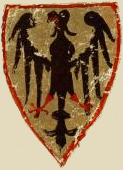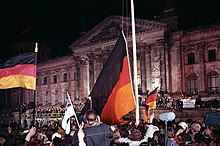National colours of Germany

The
The colours ultimately hark back to the tricolour adopted by the Urburschenschaft of Jena in 1815, representing an early phase in the development of German nationalism and the idea of a unified German state. Since the 1860s, there has been a competing tradition of national colours as black, white, and red, based on the Hanseatic flags, used as the flag of the North German Confederation and the German Empire. The Weimar Republic in 1919 opted to re-introduce the black, red, and gold tricolour. This was controversial, and as a compromise, the old flag was reintroduced in 1922 to represent German diplomatic missions abroad. As a reaction, Reichsbanner Schwarz-Rot-Gold was an organization formed in 1924 representing the parties supporting parliamentary democracy, and for the remainder of the existence of the Weimar Republic, black-red-gold represented the centrist parties supporting parliamentary and black-white-red represented its nationalist and monarchist opposition.
Black, red, and gold
Supposed pre-modern origins

The choice of black, red, and gold as national colours was retrospectively motivated by occurrence of this combination of colours in the medieval coat of arms of the
The Habsburg monarchy used the colours black and gold as its dynastic flag from about 1700; when emperor Francis II abdicated from the throne in 1806, he adopted the colours as the flag of his Austrian Empire.[clarification needed]
The black-red-gold tricolour's first known appearance on a state flag, anywhere in a German-ethnicity
Communist authors also attributed use of the colours by insurgents of the 1525 German Peasants' War, so Friedrich Engels in his The Peasant War in Germany (1850, p. 91), and Albert Norden, Um die Nation (1953, p. 17).
Wars of Liberation

Uniforms of the
Black, red, and gold – if even in reverse order compared to nowadays, i.e. gold at the top – resembling the former imperial colours soon became symbols of the German struggle for freedom, symbolizing the road from servitude (black) through bloody fight (red) to the stars (gold), similar to the famous saying
The students' hopes of a national awakening dashed with the implementation of the
March Revolution

As a result of the 1848 revolutions, the
When on 18 May 1848 the Frankfurt Parliament first convened, the city streets were decorated in the "German colours" like the assembly room in St. Paul's Church. On November 12, the parliament passed a resolution whereafter black-red-gold became the German war and merchant flag. However, as official flag of the German Confederation, the tricolour was mainly used in the small Imperial fleet (Reichsflotte), which was dissolved by 1852. The Frankfurt Constitution, adopted in 1849 and never carried into effect, omitted any provision of national symbols. After the dissolution of the Frankfurt Parliament, the tricolour vanished from public space. Mocked by Heinrich Heine as "old Germanic rubbish", it nevertheless remained the official flag of the German Confederation, "revitalized" in 1866 as the banner of Austria and her allies in the War with Prussia and the North German states.
Black, white, and red

After the war and the breakup of the German Confederation, the Prussian-led North German Confederation was established at the instance of Minister-President Otto von Bismarck to answer the German question. Another colour scheme was desired, as the black and gold colours were associated with Habsburg Austria. From 1867, the black, white, and red colours became the flag of the newly established federated state; the tricolour derived from the combination of the Prussian black and white with the white and red flag of the North German Hanseatic League.
Since the 13th century, a black cross on white coat had been carried by medieval
In addition to the black and white of Prussia, the white and red colours of the former

From the 1871
State colours
In the
Weimar Republic
Though even liberal deputies in the Weimar National Assembly spoke against a change of colours, Article 3 of the German Constitution of 11 August 1919 determined black, red, and gold both for the tricolour national flag and the eagle coat of arms of the Weimar Republic. Considering the preceding debates however, the former black, white, and red colours were retained as the German civil ensign, with black, red, and gold in the upper left corner. Not until 1922, the Reichskriegsflagge banner was officially outlawed on ships of the German Navy. The official black, red, and gold colours were refused by wide circles in the Reichswehr armed forces and World War I veterans' associations.
The issue of the national colours was, however, continuously debated in the German society.
To encounter antidemocratic forces, the
Nazi rule
Upon the
After Hindenburg's death on 2 August 1934, Hitler styled himself
Post-war

After
In the Federal Republic of Germany (since 1949), and especially after the 1960s, only very
Use of colours in sports

German sports teams often use white as a main colour, as organisations that had been founded prior to 1919 often have chosen the
Between 1918 and 1933, and after 1945, black-red-gold again became the national colours. Organisations founded in that time frame, such as the German
See also
- Flag of Germany
- List of flags of Germany
- Flags of German states
References
- ^ The "gold" (Or) is nearly always represented by a shade of yellow, as there is no distinct color "yellow" in heraldry; they both count as "gold".
- ^ Article 22 sec. 2 of the German Basic Law constitution: Die Bundesflagge ist schwarz-rot-gold. ("The federal flag shall be black, red, and gold.").
- ^ George Henry Preble: The symbols, standards, flags, and banners of ancient and modern nations, prior to 1900, reprint: Flag Research Center, Winchester, USA.[page needed]
- ^ "Das Leichtathletik-Portal - Start".
- ^ "Home". rudern.de.
- ^ "Home". afvd.de.
- ^ "IG Nov". Archived from the original on 2007-06-27. Retrieved 2007-07-05.
- Die Sendung mit der Maus – Die deutsche Flagge – Origins of the German flag and its colours (German video)
